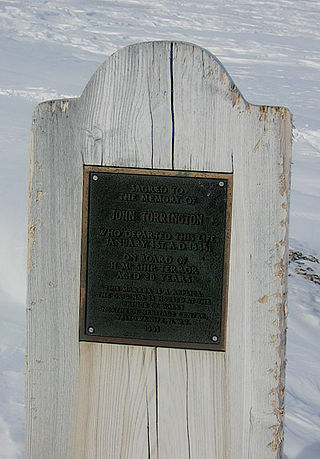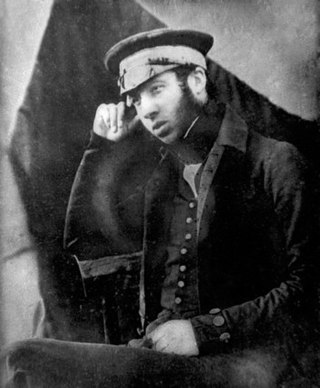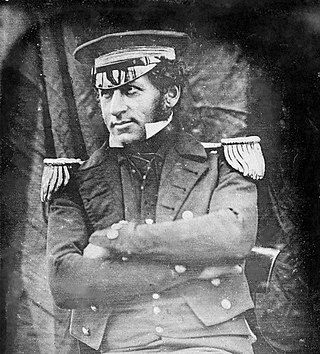
Sir John Franklin was a British Royal Navy officer, explorer and colonial administrator. After serving in the Napoleonic Wars and the War of 1812, he led two expeditions into the Canadian Arctic and through the islands of the Arctic Archipelago, during the Coppermine expedition of 1819 and the Mackenzie River expedition of 1825, and served as Lieutenant-Governor of Van Diemen's Land from 1837 to 1843. During his third and final expedition, an attempt to traverse the Northwest Passage in 1845, Franklin's ships became icebound off King William Island in what is now Nunavut, where he died in June 1847. The icebound ships were abandoned ten months later, and the entire crew died from causes such as starvation, hypothermia, and scurvy.

HMS Erebus was a Hecla-class bomb vessel constructed by the Royal Navy in Pembroke dockyard, Wales, in 1826. The vessel was the second in the Royal Navy named after Erebus, the personification of darkness in Greek mythology.

HMS Resolute was a mid-19th-century barque-rigged ship of the British Royal Navy, specially outfitted for Arctic exploration. Resolute became trapped in the ice searching for Franklin's lost expedition and was abandoned in 1854. Recovered by an American whaler, she was returned to Queen Victoria in 1856. Timbers from the ship were later used to construct the Resolute desk which was presented to the President of the United States and is located in the White House Oval Office.

King William Island is an island in the Kitikmeot Region of Nunavut, which is part of the Arctic Archipelago. In area it is between 12,516 km2 (4,832 sq mi) and 13,111 km2 (5,062 sq mi) making it the 61st-largest island in the world and Canada's 15th-largest island. Its population, as of the 2021 census, was 1,349, all of whom live in the island's only community, Gjoa Haven.

HMS Terror was a specialised warship and a newly developed bomb vessel constructed for the Royal Navy in 1813. She participated in several battles of the War of 1812, including the Battle of Baltimore with the bombardment of Fort McHenry. She was converted into a polar exploration ship two decades later, and participated in George Back's Arctic expedition of 1836–1837, the successful Ross expedition to the Antarctic of 1839 to 1843, and Sir John Franklin's ill-fated attempt to force the Northwest Passage in 1845, during which she was lost with all hands along with HMS Erebus.
Beechey Island is an island located in the Arctic Archipelago of Nunavut, Canada, in Wellington Channel. It is separated from the southwest corner of Devon Island by Barrow Strait. Other features include Wellington Channel, Erebus Harbour, and Terror Bay.

Francis Rawdon Moira Crozier was an Irish officer of the Royal Navy and polar explorer who participated in six expeditions to the Arctic and Antarctic. In 1843, he became a Fellow of the Royal Society for his scientific work during his expeditions. Later, he was second-in-command to Sir John Franklin and captain of HMS Terror during the Franklin expedition to discover the Northwest Passage, which ended with the loss of all 129 crewmen in mysterious circumstances.

"Lady Franklin's Lament" is a traditional folk ballad indexed by George Malcolm Laws and Steve Roud. The song recounts the story of a sailor who dreams about Lady Franklin speaking of the loss of her husband, Sir John Franklin, who disappeared in Baffin Bay during his 1845 expedition through the Arctic Ocean in search of the Northwest Passage sea route to the Pacific Ocean. The song first appeared as a Broadside ballad around 1850 and has since been recorded with the melody of the Irish traditional air "Cailín Óg a Stór" by numerous artists. It has been found in Ireland, in Scotland, and in some regions of Canada.

John Shaw Torrington was a Royal Navy stoker. He was part of the 1845 Franklin Expedition to chart unexplored areas of what is now Nunavut, Canada, find the Northwest Passage, and make scientific observations. He was the first fatality of the expedition, of which all personnel ultimately died, mostly in and around King William Island. Torrington was buried on Beechey Island. His body was exhumed by forensic anthropologist Owen Beattie in 1984, to try to determine the cause of death. His remains are among the best preserved example of a corpse since the ancient Tollund Man which was found in the 1950s. Photographs of his mummified remains were widely published and inspired music and literature.

Franklin's lost expedition was a failed British voyage of Arctic exploration led by Captain Sir John Franklin that departed England in 1845 aboard two ships, HMS Erebus and HMS Terror, and was assigned to traverse the last unnavigated sections of the Northwest Passage in the Canadian Arctic and to record magnetic data to help determine whether a better understanding could aid navigation. The expedition met with disaster after both ships and their crews, a total of 129 officers and men, became icebound in Victoria Strait near King William Island in what is today the Canadian territory of Nunavut. After being icebound for more than a year Erebus and Terror were abandoned in April 1848, by which point two dozen men, including Franklin, had died. The survivors, now led by Franklin's second-in-command, Francis Crozier, and Erebus's captain, James Fitzjames, set out for the Canadian mainland and disappeared, presumably having perished.
John Grigsby Geiger is an American-born Canadian author. He is best known for his book The Third Man Factor: Surviving the Impossible, which popularized the concept of the "third man", an incorporeal being that aids people under extreme duress. The book is the basis for a National Geographic Channel video entitled Explorer: The Angel Effect, in which Geiger appears. In turn, a second book on the topic, based on, and taking its name from the National Geographic video, was published in 2013. His other works include the international bestseller Frozen in Time: The Fate of the Franklin Expedition.
William Braine was a British explorer. He served as a marine in the Royal Marines. From 1845 he was part of an expedition to find the Northwest Passage, but he died early in the trip and was buried on Beechey Island. His preserved body was exhumed in 1984, to try to determine the cause of death.
John Hartnell was an English seaman who took part in Sir John Franklin's Northwest Passage expedition and was one of its first casualties, dying of suspected zinc deficiency and malnourishment during the expedition's first year.
Owen Beattie is a Canadian professor of anthropology at the University of Alberta.

Henry Duncan Spens Goodsir was a Scottish physician and naturalist who contributed to the pioneering work on cell theory done by his brother John Goodsir. He served as surgeon and naturalist on the ill-fated Franklin expedition. His body was never found, but forensic studies in 2009 on skeletal remains earlier recovered from King William Island in Canada suggest that they may be those of Harry Goodsir.

Graham Gore was an English officer of the Royal Navy and polar explorer who participated in two expeditions to the Arctic and a survey of the coastline of Australia aboard HMS Beagle. In 1845 he served under Sir John Franklin as First Lieutenant on the Erebus during the Franklin expedition to discover the Northwest Passage, which ended with the loss of all 129 officers and crewmen in mysterious circumstances.
Frozen in Time is a 2005 album by American death metal band Obituary.

Henry Thomas Dundas Le Vesconte was an English officer of the Royal Navy and polar explorer who from 1845 served under Sir John Franklin as Second Lieutenant on the Erebus during the Franklin expedition to discover the Northwest Passage, which ended with the loss of all 129 crewmen in mysterious circumstances.

James Walter Fairholme was a British Royal Navy officer and polar explorer who in 1845 served under Sir John Franklin on the Erebus during the Franklin expedition to discover the Northwest Passage, which ended with the loss of all 129 crewmen in mysterious circumstances.
John Gregory was an English railway and naval engineer. He served as engineer aboard HMS Erebus during the 1845 Franklin Expedition, which sought to explore uncharted parts of what is now Nunavut, including the Northwest Passage, and make scientific observations. The ships were outfitted with former railway locomotive engines which served as auxiliary power units, which is why Gregory, who had never been to sea, served on the expedition. All expedition personnel perished in uncertain conditions, mostly on and around King William Island. In 2021, Gregory's remains became the first of the expedition to be identified using DNA analysis.













